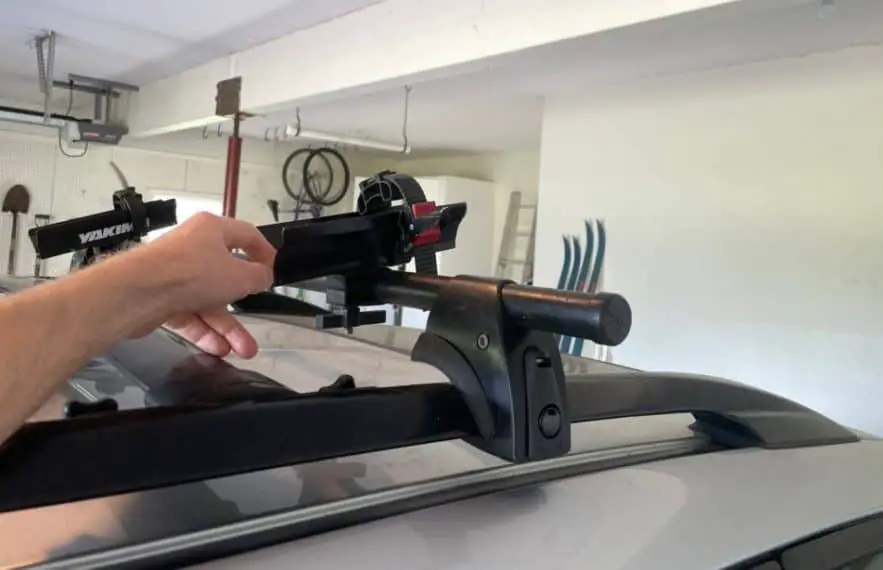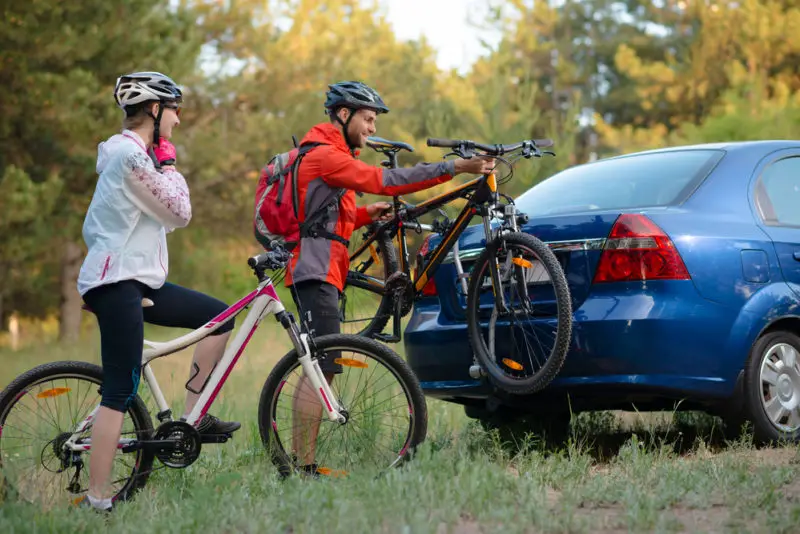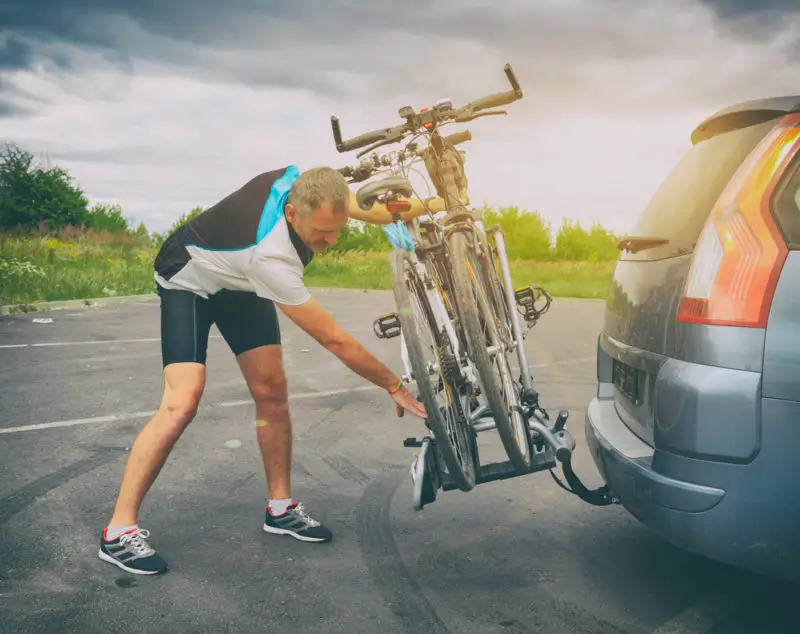You love your bike, and you’ll go to great lengths to protect it. But how much thought do you give to your bike rack? Bike racks can be heavy, cumbersome, and take time to install on your car. So what do you do with your rack when you’re not using it? Should you leave it on your car? Or should you take it off every time you use it?
There are a number of reasons why you may not want to leave a bike rack attached to your car when not in use. The rack can block access to your car’s trunk, it could get stolen, make you more prone to accidents while driving, decrease your fuel efficiency, or even be illegal if it blocks your license plate.
So let’s talk about the reasons why it might be best to remove your bike rack when you aren’t using it, when it’s ok to leave it in place, and how to store it as well.
Can You Leave a Bike Rack on Your Car?

Technically, yes, you can leave your bike rack on your car whenever you want. If installed correctly, it won’t do any damage to your vehicle. Cyclists who ride frequently or use a rack that’s challenging to install may be more inclined to leave their bike rack on their car all of the time, especially if the rack is heavy or difficult to remove.
If you use your rack frequently, you may feel like it’s not worth the trouble of removing it after every ride. However, there are some very compelling reasons to remove your rack from your car when you aren’t using it.
Why NOT to Leave a Bike Rack on Your Car

Leaving your bike rack attached all the time certainly saves time when you’re heading out on a ride. But consider these reasons why you might not want to leave your bike rack on your car:
It Gets in the Way
One simple reason not to leave your bike rack on your car is that it just gets in the way. For example, if you use a trunk rack, it may be impossible to open the trunk without first removing the rack. A hitch rack can block access to your trunk as well, unless you have a version that folds down.
Even so, because a hitch rack sticks out from the rear of your car, it can make it difficult to get things in and out of your trunk. You might have trouble loading groceries or other items when you can’t get as close to your trunk as when the rack isn’t installed.
And not to mention how many times I’ve busted my shins on the hitch rack when I’m carrying heavy things and not looking down!
Makes Accidents More Likely
A rack on the back of your trunk can make accidents more likely to happen. A trunk or hitch rack may obstruct rear visibility, or even block your car’s backup camera, making it more difficult to see pedestrians or other cars behind you.
A heavy hitch rack may also affect your car’s handling, just like a roof rack could impact steering in heavy winds. Hitch and trunk racks also make your vehicle’s profile longer, which could result in an accident if you don’t take your vehicle’s new length into account. What’s worse than thinking you have plenty of room to back up, only to ram your bike rack into someone’s parked car?
Decreases Fuel Efficiency
Gas is expensive! And the wind drag on a rack or a rack’s heavy weight may cause a drop in your vehicle’s fuel efficiency. According to Consumer Reports, even an empty bike rack on your vehicle results in a noticeable reduction in fuel economy. This is more pronounced with roof racks, and even more so if you have a smaller car: an empty roof rack on a sedan can reduce fuel efficiency by 11%!
Some of the numbers in this report may seem small, but the cost will definitely add up over time, making it worthwhile to remove the rack from the car when not in use.
It Might Get Stolen
Unfortunately, if you leave your rack on your car at all times, it is more likely to get stolen. And while rack theft isn’t as common as bike theft, it does happen. So if you are going to leave your car in a sketchy area or aren’t planning on driving for a while, removing the rack could save you a lot of money and frustration.
Increases Risk of Weather Damage
Leaving your rack on your car results in an increased risk of damage from the weather. Rain, snow, road salt and chemicals can wear away the finish on your rack. Road grime can work its way into the nuts and bolts, making them difficult to remove. And the sun’s UV rays can discolor plastic and degrade the nylon straps or foam cushioning on your rack as well.
I’ve left my hitch rack mounted all the time for the past year (bad move!) and I’ve definitely noticed a moderate amount of rust and discoloration, as well as more wobble than when I first bought it. The less your bike rack is exposed to the elements, the longer it will last. Bike racks are expensive…you don’t want to have to replace it before you need to.
It Could Be Illegal
In all states, it is illegal to have your license plate obscured. While some states make exceptions for bike racks, not all do, so you should be well-informed about a state’s laws regarding license plate visibility before traveling there.
Bicycle Universe shares some insight on bike rack laws, but you’ll want to check with your municipality to find out what applies to you.
When to Remove Your Bike Rack

How do you know when to remove your bike rack? Well, it depends on how often you ride your bike and how difficult it is to remove and store your rack. You’ll need to balance protecting your bike rack with how hard it is to install on your car.
Do you live where there is a riding off-season? If you do, you might want to remove your rack in the off-season. There’s really no reason to leave your bike rack attached to your vehicle if you aren’t going to be using it for a couple of months anyway. You are better off removing it for the winter and putting it back on once the weather warms up.
On the other hand, when the weather is balmy, cyclists who ride several times per week may choose to leave their rack on. So if you ride frequently, it may make sense to leave the rack in place most of the time. If you only ride once a week or less, you should consider removing it in between rides for the safety and protection of the rack and your car.
That being said, you’ll want to stash your rack safely and carefully when you decide it’s time to remove it.
How to Store Your Car Bike Rack
Your car bike rack is an investment, so you’ll want to take care of it even when it isn’t on your vehicle. If you have a hitch rack, they can take up a lot of floor space in your garage. So you might want to invest in something like a Rack Stash.
A Rack Stash works with most hitch racks. It’s a metal bracket that you can attach to your garage wall. You insert the bike hitch rack into the bracket much like you would insert it into the hitch of your car. The Rack Stash lifts your rack up and out of the way, keeping it safe and saving you floor space.
If you have a trunk rack, you should be able to remove the rack and fold it up. Then you can store it in your trunk or safely on a shelf in your garage.
Regardless of what type of rack you have, keep it in a secured area away from bad weather. Don’t leave it in your yard, hanging on a fence, or tossed in a damp basement because poor conditions could degrade your rack, causing it to break or become unsafe to use.
